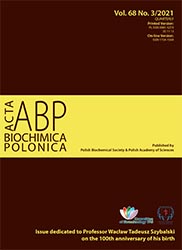Metabolic evolutionary roots of the macrophage immune response in amoeba-bacteria interactions: The conserved role of hypoxia-induced Factor and AMP kinase
Abstract
The bacteria Legionella, being able to infect both macrophages and protozoans, reduce oxidative phosphorylation and induce glycolysis, which allows pathogens to grow and replicate in these cells. In amoeba-like inflammatory macrophages (M1), the phagocytizing cells of the primary immune defense, an increase in the rate of glycolysis is followed by a decrease of oxidative phosphorylation. The opposite takes place in anti-inflammatory macrophages (M2). They change from glycolysis to oxidative metabolism when AMP-dependent kinase (AMPK) is activated by a high ratio of AMP/ATP. Stimulation of macrophages with anti-inflammatory cytokines causes activation of AMPK. Infection of macrophages with the parasitic flagellate Leishmania infantum induces a switch from an initial glycolytic phase to oxidative phase with the essential role of AMPK in this change. Activated AMPK induces catabolic pathways effectively producing ATP as well as processes requiring the energy supply. AMPK regulates the migration of cells and enhances the phagocytic activity of macrophages. In macrophages, bacterial products activate TLRs and NF-κB signaling, causing an increase of transcription of hypoxia-induced factor HIF-1α (a subunit of HIF-1). This brings about induction of the enzyme and transporter expression essential for glycolysis and the pentose phosphate pathway to proceed and makes biosynthetic processes and ROS production in macrophages possible. Hypoxia augments macrophage phagocytosis in a HIF‐1α‐dependent manner. Multicellular parasites experience changes in the availability of oxygen in their life cycle. In the nematode Ascaris suum, HIF participates in the pre-adaptation to hypoxic conditions after infection of their hosts. Also, the freshwater and marine invertebrates meet changes of oxygen concentrations. In the anaerobic branch of the respiratory chain of these invertebrates, fumarate serves as the terminal electron acceptor that is reduced to succinate in complex II of the ETC. In mammalian cells, accumulation of succinate under hypoxic conditions suggests that the mammalian complex II may reduce fumarate to succinate, too. The data reviewed here show that the ability to shift the cell metabolism towards glycolysis observed in activated macrophages can be traced back in evolution to metabolic changes characterizing protozoans infected with bacteria. Anabolic needs of multiplying bacteria direct host metabolism to glycolysis that produces, aside from ATP, precursors of the amino acids used by the pathogen for its protein synthesis. M1-activated mammalian macrophages behave in the same way. Regulation of metabolism in M1 and M2 macrophages is further enhanced by HIF-1 and AMPK, respectively. These archaic functions of AMPK and HIF, important also to control phagocytosis and cell migration were extended to embryonic development in multicellular organisms.
Acta Biochimica Polonica is an OpenAccess quarterly and publishes four issues a year. All contents are distributed under the Creative Commons Attribution-ShareAlike 4.0 International (CC BY 4.0) license. Everybody may use the content following terms: Attribution — You must give appropriate credit, provide a link to the license, and indicate if changes were made. You may do so in any reasonable manner, but not in any way that suggests the licensor endorses you or your use.
Copyright for all published papers © stays with the authors.
Copyright for the journal: © Polish Biochemical Society.


